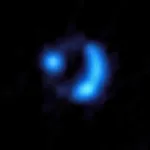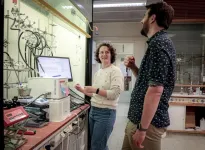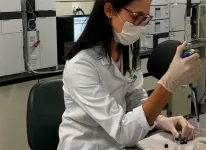The discovery of a new kind of cell shakes up neuroscience
2023-09-06
(Press-News.org)
Neuroscience is in great upheaval. The two major families of cells that make up the brain, neurons and glial cells, secretly hid a hybrid cell, halfway between these two categories. For as long as Neuroscience has existed, it has been recognized that the brain works primarily thanks to the neurons and their ability to rapidly elaborate and transmit information through their networks. To support them in this task, glial cells perform a series of structural, energetic and immune functions, as well as stabilize physiological constants. Some of these glial cells, known as astrocytes, intimately surround synapses, the points of contact where neurotransmitters are released to transmit information between neurons. This is why neuroscientists have long suggested that astrocytes may have an active role in synaptic transmission and participate in information processing. However, the studies conducted to date to demonstrate this have suffered from conflicting results and have not reached a definitive scientific consensus yet. By identifying a new cell type with the characteristics of an astrocyte and expressing the molecular machinery necessary for synaptic transmission, neuroscientists from the Department of Basic Neurosciences of the Faculty of Biology and Medicine of the University of Lausanne (UNIL) and the Wyss Center for Bio and Neuroengineering in Geneva put an end to years of controversy.
The Key to the Puzzle
To confirm or refute the hypothesis that astrocytes, like neurons, are able to release neurotransmitters, researchers first scrutinized the molecular content of astrocytes using modern molecular biology approaches. Their goal was to find traces of the machinery necessary for the rapid secretion of glutamate, the main neurotransmitter used by neurons. "The precision allowed by single-cell transcriptomics approaches enabled us to demonstrate the presence in cells with astrocytic profile of transcripts of the vesicular proteins, VGLUT, in charge of filling neuronal vesicles specific for glutamate release. These transcripts were found in cells from mice, and are apparently preserved in human cells. We also identified other specialized proteins in these cells, which are essential for the function of glutamatergic vesicles and their capacity to communicate rapidly with other cells," says Ludovic Telley, Assistant professor at UNIL, co-director of the study.
New Functional Cells
Next, neuroscientists tried to find out if these hybrid cells were functional, that is, able to actually release glutamate with a speed comparable to that of synaptic transmission. To do this, the research team used an advanced imaging technique that could visualize glutamate released by vesicles in brain tissues and in living mice. "We have identified a subgroup of astrocytes responding to selective stimulations with rapid glutamate release, which occurred in spatially delimited areas of these cells reminiscent of synapses," says Andrea Volterra, honorary professor at UNIL and visiting faculty at the Wyss Center, co-director of the study.
In addition, this glutamate release exerts an influence on synaptic transmission and regulates neuronal circuits. The research team was able to demonstrate this by suppressing the expression of VGLUT by the hybrid cells. "They are cells that modulate neuronal activity, they control the level of communication and excitation of the neurons," says Roberta de Ceglia, first author of the study and senior researcher at UNIL. And without this functional machinery, the study shows that long-term potentiation, a neural process involved in the mechanisms of memorization, is impaired and that the memory of mice is impacted.
Links With Brain Pathologies
The implications of this discovery extend to brain disorders. By specifically disrupting glutamatergic astrocytes, the research team demonstrated effects on memory consolidation, but also observed links with pathologies such as epilepsy, whose seizures were exacerbated. Finally, the study shows that glutamatergic astrocytes also have a role in the regulation of brain circuits involved in movement control and could offer therapeutic targets for Parkinson's disease.
"In between neurons and astrocytes, we now have a new kind of cell at hand. Its discovery opens up immense research prospects. Our next studies will explore the potential protective role of this type of cell against memory impairment in Alzheimer's disease, as well as its role in other regions and pathologies than those explored here," projects Andrea Volterra.
END
ELSE PRESS RELEASES FROM THIS DATE:
2023-09-06
By improving hospital care pathways, researchers from The University of Texas MD Anderson Cancer Center successfully reduced inpatient opioid use by 50% after pancreatic cancer surgery and cut the median opioid prescription volumes at discharge to zero. This approach, described in a study published today in JAMA Surgery, could help reduce the risk of long-term opioid dependence in patients.
In this cohort study, which involved 832 patients undergoing pancreatic resection surgery, the researchers investigated how making incremental modifications to post-surgery procedures affected the amounts of opioids used by inpatients and at the point of discharge. In less ...
2023-09-06
Analysis led by Brigham researchers showed an increase in out-of-state abortion travelers to Massachusetts from other states including Texas, Louisiana, Florida, and Georgia after Dobbs.
Use of non-profit funding by charitable organizations for abortion care more than doubled among out-of-state travelers
A rigorous analysis by researchers confirms a rise in out-of-state travelers coming to Massachusetts to seek abortion care. In a new study by investigators from Brigham and Women’s Hospital, a founding member ...
2023-09-06
About The Study: Researchers identified decreases of in situ and invasive melanoma diagnoses during 2020, which may reflect decreased skin cancer screening examinations or access to dermatologic care during the pandemic, both of which may lead to reduced melanoma diagnoses. This study adds to the current literature by highlighting that the relative increase in thick melanomas in 2020 was primarily associated with a marked decrease in thin melanomas, rather than an absolute increase in thicker melanomas.
Authors: Rebecca I. Hartman, M.D., M.P.H., of Brigham and Women’s Hospital in Boston, is the corresponding author.
To access the embargoed study: Visit ...
2023-09-06
About The Study: This study found large increases in cannabis involvement in emergency department visits for traffic injury over time in Ontario, Canada, which may have accelerated following nonmedical cannabis commercialization. Although the frequency of visits was rare, they may reflect broader changes in cannabis-impaired driving. Greater prevention efforts, including targeted education and policy measures, in regions with legal cannabis are indicated.
Authors: Daniel T. Myran, M.D., M.P.H., of the University of Ottawa in Ottawa, Ontario, Canada, is the corresponding author.
To access the embargoed study: Visit our For The Media website at this link https://media.jamanetwork.com/
(doi:10.1001/jamanetworkopen.2023.31551)
Editor’s ...
2023-09-06
Using the Atacama Large Millimeter/submillimeter Array (ALMA), astronomers have detected the magnetic field of a galaxy so far away that its light has taken more than 11 billion years to reach us: we see it as it was when the Universe was just 2.5 billion years old. The result provides astronomers with vital clues about how the magnetic fields of galaxies like our own Milky Way came to be.
Lots of astronomical bodies in the Universe have magnetic fields, whether it be planets, stars or galaxies. “Many people ...
2023-09-06
Oscillating chemical systems are present at nearly every popular chemistry exhibition – especially the ones that display striking colour changes. But so far there are very few practical uses for these types of reactions beyond timekeeping. In nature, on the other hand, many important life processes such as cell division and circadian rhythms involve oscillations. Scientists at the University of Groningen have now developed an oscillating system that contains a catalyst, and exhibits periodic catalytic activity: this synthetic chemical oscillator can do more than just keep time. A description of this ...
2023-09-06
LA JOLLA, CA—Scripps Research chemists have extended a powerful molecule-building method—called C-H activation—to the broad class of chemicals known as alcohols.
The synthetic chemistry feat, reported in Nature on September 6, 2023, follows the development of C-H activation techniques for the three other major classes of organic molecule—amines, acids and ketones—that are used to construct pharmaceuticals. It gives chemists a versatile new toolkit for making drugs and other valuable compounds now using the alcohol chemical class; moreover, its ...
2023-09-06
PITTSBURGH – To reimagine existing preclinical trials for Alzheimer’s disease, University of Pittsburgh School of Medicine neuroscientists created the first non-human primate model of hereditary Alzheimer's in marmoset monkeys, outlining their approach in Alzheimer's & Dementia: Translational Research & Clinical Interventions.
Researchers are now working on characterizing and validating genetic, molecular, functional and cognitive features of aging and Alzheimer’s disease in marmosets that harbor mutations in the same gene that is linked to early-onset disease in humans. Scientists hope to accelerate the pace of the ...
2023-09-06
Oral health deteriorates in morbidly obese people on a diet in preparation for bariatric surgery and patients who have undergone the procedure, with increasing caries, gingivitis and periodontitis. This is the conclusion of a study conducted by researchers at the Federal University of São Paulo (UNIFESP) in Brazil. Articles on the study are published in the Journal of Oral Rehabilitation and Clinical Oral Investigations, stressing the importance of participation by a dentist in the assessment of bariatric patients.
The study was funded by FAPESP (projects 17/26400-6 and 16/10940-9), following 100 patients divided into two groups (dietary ...
2023-09-06
Patients with acute myeloid leukemia (AML) who received vitamin C and D supplements while undergoing intensive chemotherapy had lower rates of complications, such as infections, bleeding, and inflammation, when compared with similar, previously treated patients who did not receive these supplements. Moreover, while the study showed no difference in survival between the two groups, a subgroup analysis showed that among patients with a genetic mutation known as NPM1 – found in about one in three patients with AML – the risk of death was nearly 50% lower among those ...
LAST 30 PRESS RELEASES:
[Press-News.org] The discovery of a new kind of cell shakes up neuroscience



